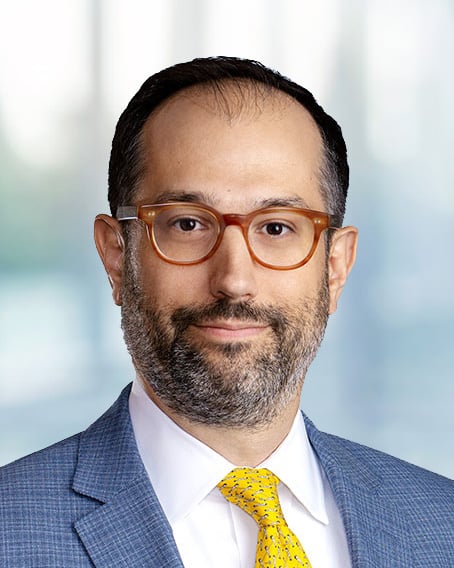In this second episode of our ETF podcast series, Ropes & Gray asset management attorneys Jeremy Smith, Brian McCabe, and Ed Baer discuss the impact of the fund-of-funds rule on ETFs.
Transcript:
Brian McCabe: Hello and thank you for joining us today on this Ropes & Gray podcast. I'm Brian McCabe, a partner in the Boston office of Ropes & Gray. Joining me today are two of my colleagues from the asset management practice group: Jeremy Smith, a partner in our New York City office, and Ed Baer, who is counsel in our San Francisco office. In this podcast, which is part of a series of podcasts on ETF issues, we will cover some ETF-related issues and questions that may arise as a result of the SEC’s recent adoption of Rule 12d1-4, the so-called “fund-of-funds” rule. To begin, let’s talk about some of the key terms of the Rule. Jeremy, what harms are the Rule’s conditions guarding against?
Jeremy Smith: I think the Rule tries to address with more teeth the same ills that Section 12 seeks to address – those include:
- complex multi-tier fund of fund arrangements;
- duplication of investment advisory fees and other expenses at different levels of those multi-tier arrangements; and
- abusive practices by acquiring funds in fund of fund arrangements that concentrate voting power and have the ability to influence underlying funds based on the threat of redemptions or through the voting of proxies.
Brian McCabe: How does the Rule attempt to limit abusive practices of acquiring funds and limit the creation of complex multi-tier arrangements?
Jeremy Smith: The Rule does this in a number of ways, but some of the principal protections have implications for the investment process. First, to limit complex multi-tier arrangements, acquired funds in fund of fund arrangements relying on the Rule or on Section 12(d)(1)(G) must limit their own investments in other investment companies and private funds to no more than 10% of their total assets. Second, an acquiring fund together with its advisory group cannot control an acquired fund, and must mirror vote any shares they come to own in excess of 25% of the acquired fund’s shares.
Brian McCabe: Normally, affiliated funds get a pass on some requirements because there’s less risk of an adviser abusing its own funds. Jeremy, will that still be the case under the Rule?
Jeremy Smith: Yes, the control prohibition and the mirror voting provision I mentioned do not apply if the involved funds are part of the same group of investment companies or the acquiring fund’s sub-adviser (or someone in a control relationship with the sub-adviser) is also the acquired fund’s adviser.
Brian McCabe: Okay, well that’s a good start. We still haven’t addressed the duplication of fees and expenses point, and there’s still that threat of large-scale redemptions hanging out there. Ed, what other measures does the Rule impose to combat these issues?
Ed Baer: The Rule seeks to get at those issues with required evaluations and fund findings, and a required agreement between the funds. First, the acquiring fund’s adviser must evaluate the complexity of the structure and fees and expenses, and find that the acquired fund’s fees and expenses do not duplicate the acquiring fund’s fees and expenses. Second, the acquired fund’s adviser must find that any undue influence concerns associated with the investment have been addressed, and must consider in that regard, at a minimum:
- the scale of the investment and any maximum investment limits,
- the anticipated timing of redemption requests by the acquiring fund,
- whether and under what circumstances the acquiring fund will provide advance notice of investments and redemptions, and
- the circumstances and terms under which the acquired fund would meet redemptions in kind.
Third, as a condition of relying on the Rule, the acquired fund and acquiring fund must enter into an agreement with each other that facilitates the exchange of information about fees and expenses to aid in an evaluation of the findings I just mentioned.
Brian McCabe: I have to ask here too – don’t affiliated funds get a pass?
Ed Baer: Yes, but the pass is more limited. The agreement I mentioned isn’t necessary where the same primary investment adviser serves as the adviser to both the acquiring and acquired funds. Unfortunately, these related funds don’t get the same pass when the adviser’s only a sub-adviser to one of the funds.
Brian McCabe: Okay, and I bet you’re going to tell me that board reporting is required too.
Ed Baer: Yes, it certainly is. The adviser to each acquiring fund or acquired fund must report its evaluations and findings, including the adviser’s underlying reasoning, to their respective fund’s boards, no later than the next regularly scheduled board meeting and at least annually thereafter. And, before you ask, the conditions apply to both affiliated and unaffiliated fund-of-funds arrangements.
Jeremy Smith: Brian, so we know now that the funds in fund of fund arrangements relying on the rule (except where they have the same primary adviser) will have to have these agreements with each other. What’s the bare minimum that these agreements need to have in them?
Brian McCabe: The required elements are:
- Any material terms regarding the acquiring fund’s investment in the acquired fund necessary to make the required fund findings regarding potentially duplicative fees and undue influence concerns;
- A termination provision permitting either fund to terminate the agreement upon no more than 60 days’ written notice, and
- A requirement that the acquired fund provide the acquiring fund with information on the fees and expenses of the acquired fund reasonably requested by the acquiring fund.
Jeremy Smith: Okay, so that’s what the law says. How do you think things will develop in practice? What do you think funds might actually seek to bargain for in these agreements?
Brian McCabe: Acquiring funds might seek to include an acknowledgement from the acquired fund that its investments in investment companies will be limited to the 10% of net assets – the 10% bucket that Jeremy alluded to earlier. In addition, for acquired funds, the agreement might include notice provisions whereby the acquiring fund commits to provide advance notice of additional large subscriptions or redemptions, where practicable and consistent with the relevant fiduciary obligations of the adviser. This also might involve a commitment by the acquiring fund to agree to limit redemptions over certain time periods. The agreement might also provide that in the absence of compliance with those undertakings, the acquiring fund would take redemptions in kind at the acquired fund’s option. In this regard, we note that ETFs operating as acquired funds have a somewhat of an easier time here because shares of ETFs can either be sold on an exchange or redeemed in kind (with transaction costs generally externalized) and so the issues associated with large-scale redemptions may not be as problematic with acquired funds that are ETFs.
Ed Baer: Brian, since you just mentioned that ETF shares are traded on an exchange and that only APs interact with ETFs to create and redeem shares, let me ask a follow-up question: How will an acquired fund ever know if an acquiring fund is acquiring its shares through an AP, such that it would be necessary to worry about these findings and the required agreements we discussed?
Brian McCabe: To address this issue, the SEC suggests that ETFs may want to consider questioning their APs to determine whether they are acting on behalf of or intend to purchase ETF shares for investment companies. The SEC noted that ETF distributors and broker-dealers that transact in ETF shares, including APs, are subject to the provisions of Section 12(d)(1)(B). The SEC further suggested that ETFs may want to consider adopting and implementing policies and procedures to document these inquiries. The SEC stated that an ETF that explains the limitations of Section 12(d)(1)(B) to potential purchasers, and documents these exchanges with potential purchasers, generally would not knowingly sell or otherwise dispose of its securities in excess of 12(d)(1)(B), even if it later unknowingly were to sell shares to an investment company in excess of the limits in Section 12(d)(1)(B).
Ed Baer: Okay, but this seems like an intrusive new requirement applicable only to ETFs, especially if ETFs have to adopt new policies and procedures. How do you think ETFs will address the SEC’s suggestion?
Brian McCabe: It may be that ETFs can ask APs, as part of the creation order-taking process, whether they’re purchasing shares on behalf of an investment company. In addition, ETFs can put APs on notice of this issue and/or amend their AP agreements and/or AP guidelines to require APs to inform the ETF when they are acting on behalf of an investment company. An ETF can also use this disclosure to ensure that its market makers and other market participants that interact with its capital markets team understand the ETF’s intention to inquire about potential investment company purchasers.
Ed, the Rule includes quite a bit of quirkiness in that the text of the Rule is clear about when the required findings we mentioned must be made. Is it as clear about when you need a fund-of-funds agreement?
Ed Baer: It’s interesting. The Rule makes clear the fund-of-funds agreement is a condition of reliance on the Rule, but it doesn’t expressly state the point in time when the agreement must be in place, whether that’s when you go over the 3% limit on investments in another investment company or something else, like the 5% limit on an acquiring fund’s assets invested in another investment company or the 10% limit on an acquiring fund’s investments in other investment companies. The natural reading, which is supported by a statement in the Release, is that it’s required when you go over any one of those limits, but, of course, the related required findings are only required if you go over the 3% limit and so it’s not entirely clear whether the agreement serves much of a purpose if only the 5% or 10% limit is at issue. We understand this is an issue where clarification may be sought from the SEC staff, in part because an acquired fund would have no practical ability to monitor for the 5% and 10% limits on acquiring funds. This uncertainty could be easily clarified by the SEC staff, perhaps in the form of a FAQ.
Brian, under existing ETF orders, funds must execute a fund-of-funds participation agreement prior to any investment in excess of the 3/5/10% limits in Section 12(d)(1)(A). For some ETF sponsors, there may be hundreds of participation agreements in place today. What do you think will happen to all of those?
Brian McCabe: Pending the outcome of potential conversations with the SEC staff that you just mentioned, at the very least every participation agreement related to a greater than 3% investment under Section 12(d)(1)(A) will likely have to be replaced with a fund-of-funds investment agreement, and potentially all participation agreements may need to be amended to become fund-of-funds investment agreements.
Ed Baer: Jeremy, all this is a fair amount to unpack. How do you think the Rule will really impact ETFs?
Jeremy Smith: I think the Rule is a mixed bag for ETFs, but it probably affects ETFs that serve as asset allocation vehicles for other investment companies more than other ETFs. Many ETFs that are acquired funds in fund-of-funds arrangements operating under Section 12(d)(1)(G) or Rule 12d1-2 currently themselves invest without limit in other ETFs in reliance on exemptive reliefs. These orders will be rescinded and such three-tier arrangements will be far more limited under the Rule. In addition, an acquired fund, including an acquired fund ETF that needs to retain the ability to invest more than 10% of its total assets in other investment companies and private funds must forgo any investments in itself in reliance on the Rule. As I mentioned, ETFs that must choose this option will generally be of limited utility to other funds as an asset allocation tool.
Ed Baer: Alright, Jeremy, but is there an offsetting benefit in the Rule for ETFs?
Jeremy Smith: Well, it’s not really related to the point I just made, but there is a minor benefit in the Rule. The Rule clarifies that ETF baskets may be contributed and redeemed by acquiring funds that are affiliated with ETFs solely by virtue of owning 5% or more of the acquired fund’s ETF shares. The related relief baked into the Rule applies irrespective whether the fund is acting directly or indirectly through an AP.
Ed Baer: Brian, Jeremy mentioned that the 10% limit applies to an acquired fund’s investments in investment companies and private funds. Is that really as severe as it sounds?
Brian McCabe: Yes, although there are some exceptions. The following investments in investment companies are excepted and don’t count against this 10% limit:
- Investments in master funds in master/feeder relationships
- Investments in money market funds and private funds complying with 2a-7 when made in reliance on 12d1-1 (as amended)
- Investments in a wholly owned subsidiaries
- Securities received as a dividend or as a result of a plan of reorganization of a company
- Securities of another investment company received pursuant to exemptive relief from the SEC to engage in interfund borrowing and lending transactions.
These exceptions notwithstanding, this 10% limit represents a real diminution in the ability of ETFs operating as acquired funds to achieve their own asset allocation goals through investments in other investment companies and may drive acquired funds to utilize futures contracts and other derivatives rather than ETFs to obtain desired short-term exposures. In the future, I expect ETF sponsors may seek to get some measured relief from the SEC on this section, especially for niche asset classes that may otherwise be difficult to access efficiently.
Ed Baer: Jeremy, Brian noted that the 10% limit applies to investments in investment companies and private funds. What’s a private fund for this purpose – anything to be wary of?
Jeremy Smith: Yes, private funds are defined for these purposes by reference to Section 3(c)(1) and 3(c)(7) under the ‘40 Act, and certain structured products (such as some CLOs) may rely on those exemptions when offering their securities. The Rule suggests that such structured products are picked up by and subject to the Rule’s 10% bucket, so the fund industry is likely to seek clarification from the SEC staff on this point as it seems both unnecessarily restrictive and unnecessary to address the evils that Section 12(d)(1) was intended to address.
So far we’ve discussed quite a bit of work that needs to be completed and a number of questions on which the staff can hopefully provide some clarification. Brian, how long do we have to figure this all out?
Brian McCabe: Well, the Rule was just published in the Federal Register, so it takes effect on January 19, 2021. Rule 12d1-2 and various Section 12(d)(1) exemptive orders and no-action letters will be rescinded or withdrawn on January 19, 2022. That means we have less than 14 months get everything in order.
Ed Baer: That brings us to the end of the podcast. Brian, Jeremy and I want to thank all of you for joining us on this discussion of the impact of the Fund-of-Funds Rule on ETFs. For more information on the topics that we discussed or other topics of interest to asset managers and ETF sponsors, please visit our website at www.ropesgray.com where we have links to some additional material regarding these topics. To help you better understand the current ETF landscape, we will be issuing several additional podcasts designed to provide a greater depth of analysis on important and timely ETF issues. If you have any questions regarding the topics addressed today or anything else, please don't hesitate to get in touch with any one of us or whomever you already have a relationship with at Ropes. You can also subscribe and listen to the series whenever you regularly listen to podcast, including Apple and Spotify. Thank you again for listening.
Stay Up To Date with Ropes & Gray
Ropes & Gray attorneys provide timely analysis on legal developments, court decisions and changes in legislation and regulations.
Stay in the loop with all things Ropes & Gray, and find out more about our people, culture, initiatives and everything that’s happening.
We regularly notify our clients and contacts of significant legal developments, news, webinars and teleconferences that affect their industries.





